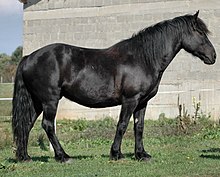Mérens horse
 A Mérens horse | |
| Other names | Ariègeois pony, Cheval de Mérens |
|---|---|
| Country of origin | France (Ariège), Spain (Ariegeois mountains) |
| Breed standards | |
The Mérens or Cheval de Mérens, still occasionally referred to by the older name of Ariegeois pony, is a small, rustic horse native to the Pyrenees and Ariègeois mountains of Spain and southern France, where the Ariège River flows. Thought to have originated in prehistoric times, it was in the past used for work in mines and for hauling timber; today it is mainly used as a saddle horse and for driving.
Characteristics
The breed is similar to the Fell and Dales Pony breeds of England.[1] The coat is always black, but may develop a distinctive reddish cast in the winter; foals may be born black, silver-grey or "coffee-coloured", but become black as they grow. White markings are rare; rabicano flecking on the flanks is popular with breeders. The average height of the Mérens is 1.49 m for males (14.2 hands, 58-1/2 in.) and 1.45 m (14.1 hands, 57 in.) for females.[2] The weight range is 350 to 500 kilograms (770 to 1,100 lb).[1]
The head of a Merens horse is small and refined, the neck is strong and short. It has a long back, a solid shoulder, and well-rounded hindquarters. The breed is valued for its hardiness and disease resistance.[3][unreliable source?]
History
The origins of the Mérens are thought to be remote, and almost certainly influenced by Arabian bloodlines. The breed is native to the Ariège Pyrenees, and the Mérens name comes from a village high in the mountains near Andorra. Cave paintings at Niaux are strikingly similar to the Mérens. The breed was long used by both farmers and soldiers throughout the Middle Ages, and later with Napoleon during his Russian campaign.[4] Selection for the current breed began in 1908.[citation needed]
Uses
In the past Mérens horses were used for farm work, particularly on steep or difficult terrain, as packhorses and for draught work in mining or hauling timber or sledges. Today, following breeding selection towards a slightly taller and livelier type, they are used principally as saddle horses, especially for trekking in mountainous areas; but have also proved successful in carriage driving.[5]
The Mérens abroad
Only two foreign breed registers are recognised by the breed standard, in the Netherlands and in Italy.[2] In Italy, the Mérens is the only foreign breed among the "breeds of limited distribution" recognised by the AIA, the national breeders' association; the horses are mostly in northwestern Italy,[5] and the breed register is located at Cuneo.[2]
See also
References
- ^ a b Bongianni, Maurizio (1988). Simon & Schuster's Guide to Horses and Ponies. Simon & Schuster, Inc. p. 150. ISBN 0-671-66068-3.
- ^ a b c "Règlement du Stud-book Français du Cheval de Mérens, 25 Janvier 2007" (PDF). Haras Nationaux (in French). Retrieved Apr 2011.
{{cite web}}: Check date values in:|accessdate=(help) - ^ "Ariegeois Horse". Horse Directory of Australia. Retrieved December 15, 2007.
- ^ "Merens Pony". Oklahoma State University. Retrieved December 15, 2007.
- ^ a b "Sezione Mérens". Associazione Provinciale Allevatori, Cuneo (in Italian). Retrieved Apr 2011.
{{cite web}}: Check date values in:|accessdate=(help)
